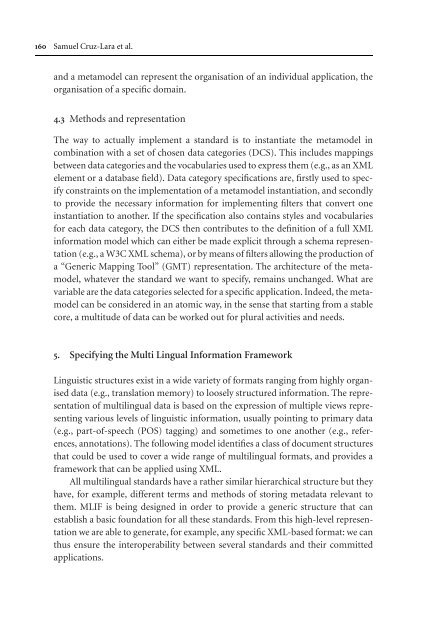Topics in Language Resources for Translation ... - ymerleksi - home
Topics in Language Resources for Translation ... - ymerleksi - home
Topics in Language Resources for Translation ... - ymerleksi - home
- No tags were found...
Create successful ePaper yourself
Turn your PDF publications into a flip-book with our unique Google optimized e-Paper software.
160 Samuel Cruz-Lara et al.and a metamodel can represent the organisation of an <strong>in</strong>dividual application, theorganisation of a specific doma<strong>in</strong>.4.3 Methods and representationThe way to actually implement a standard is to <strong>in</strong>stantiate the metamodel <strong>in</strong>comb<strong>in</strong>ation with a set of chosen data categories (DCS). This <strong>in</strong>cludes mapp<strong>in</strong>gsbetween data categories and the vocabularies used to express them (e.g., as an XMLelement or a database field). Data category specifications are, firstly used to specifyconstra<strong>in</strong>ts on the implementation of a metamodel <strong>in</strong>stantiation, and secondlyto provide the necessary <strong>in</strong><strong>for</strong>mation <strong>for</strong> implement<strong>in</strong>g filters that convert one<strong>in</strong>stantiation to another. If the specification also conta<strong>in</strong>s styles and vocabularies<strong>for</strong> each data category, the DCS then contributes to the def<strong>in</strong>ition of a full XML<strong>in</strong><strong>for</strong>mation model which can either be made explicit through a schema representation(e.g., a W3C XML schema), or by means of filters allow<strong>in</strong>g the production ofa “Generic Mapp<strong>in</strong>g Tool” (GMT) representation. The architecture of the metamodel,whatever the standard we want to specify, rema<strong>in</strong>s unchanged. What arevariable are the data categories selected <strong>for</strong> a specific application. Indeed, the metamodelcan be considered <strong>in</strong> an atomic way, <strong>in</strong> the sense that start<strong>in</strong>g from a stablecore, a multitude of data can be worked out <strong>for</strong> plural activities and needs.5. Specify<strong>in</strong>g the Multi L<strong>in</strong>gual In<strong>for</strong>mation FrameworkL<strong>in</strong>guistic structures exist <strong>in</strong> a wide variety of <strong>for</strong>mats rang<strong>in</strong>g from highly organiseddata (e.g., translation memory) to loosely structured <strong>in</strong><strong>for</strong>mation. The representationof multil<strong>in</strong>gual data is based on the expression of multiple views represent<strong>in</strong>gvarious levels of l<strong>in</strong>guistic <strong>in</strong><strong>for</strong>mation, usually po<strong>in</strong>t<strong>in</strong>g to primary data(e.g., part-of-speech (POS) tagg<strong>in</strong>g) and sometimes to one another (e.g., references,annotations). The follow<strong>in</strong>g model identifies a class of document structuresthat could be used to cover a wide range of multil<strong>in</strong>gual <strong>for</strong>mats, and provides aframework that can be applied us<strong>in</strong>g XML.All multil<strong>in</strong>gual standards have a rather similar hierarchical structure but theyhave, <strong>for</strong> example, different terms and methods of stor<strong>in</strong>g metadata relevant tothem. MLIF is be<strong>in</strong>g designed <strong>in</strong> order to provide a generic structure that canestablish a basic foundation <strong>for</strong> all these standards. From this high-level representationwe are able to generate, <strong>for</strong> example, any specific XML-based <strong>for</strong>mat: we canthus ensure the <strong>in</strong>teroperability between several standards and their committedapplications.
















